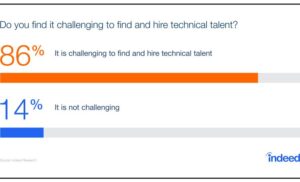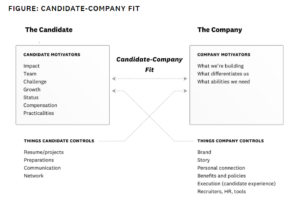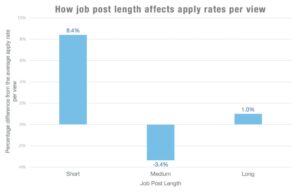As healthcare IT recruiters, we all know that the the software development landscape is ever-evolving, and so are the hiring challenges that accompany those evolutions.
One Indeed survey that interviewed around one thousand tech hiring managers and recruiters found that as many as 9 in 10 respondents said it’s challenging for them to find and recruit technical talent, with over a third saying it’s “very” challenging.

Source: Indeed
As a technical recruiter, you not only need to know how to attract top talent in the field and keep your hiring pipeline from running dry, but you also need to know how to retain the best candidates at your organization and find new avenues to keep them engaged.
It’s a lot of work for sure!
But once you know what goes into effective tech hiring, it becomes comparatively easier to ace it.
For this very reason, we’ve designed this technical hiring guide that’ll help you declutter a few basic concepts and make progress with your hiring strategy within no time.
The Only Technical Hiring Guide You Need
Table of Contents
Part 1: Foundations
Assess Your Unique Hiring Needs
Define the Candidate-Company Fit
Part 2: Internal Alignment
Define the Role
Come Up with a Strong Job Description
Choose the Right Channels to Attract Top Talent
Part 3: Connecting with Candidates
Place Emphasis on Reading a Resume Correctly
Have Impactful First Conversations
Sell the Job if the Candidate Seems to be the Right Fit
Now that you have a brief idea about what you can expect from this guide, let’s get started!
Part 1: Foundations
To begin with, you need to make sure that your technical recruiting groundwork is laid right.
Laying the groundwork right means ensuring that these two steps are taken care of:
a) Assess Your Unique Hiring Needs
To evaluate your unique hiring needs and understand whether or not you need to hire for a particular role in the first place, you will need to make sure you understand all technical terms and requirements well.
And although getting up to speed on all the programming languages, frameworks, and tools that software developers and their teams use can demand a fair amount of time, knowing commonly used, crucial terminology can prove to be a huge advantage when it comes to assessing your unique hiring needs.
This is where a technical recruiting cheat sheet comes in handy!
With several years of experience and proven expertise as an IT recruitment agency, we’ve created a highly informative cheat sheet that can take your hiring efforts to the next level and help you land the best tech candidates in in a considerably shorter period of time.
You can check it out here >>> The Ultimate Technical Recruiting Cheat Sheet
b) Define the Candidate-Company Fit
Next up, it is important that you define the candidate-company fit for your open position/s.
A hiring team or company has needs, and so does a candidate. The goal of a good recruiting process is to find shared purpose between the candidate and the company.
Candidate-company fit is nothing but a hiring goal/philosophy that emphasizes the importance of alignment between candidates and companies. The primary factors that are taken into consideration when assessing the candidate company fit are: candidate motivations, company needs, and the values each party holds.
The process is unique for each organization and role.

Source: Holloway
When it comes to deciding whether a candidate will accept an offer from your company, or even pursue a particular open position, you need to make sure you’re considering their perspective – what motivates them?
These motivators can either be extrinsic (eg: title, compensation, practical necessities like location, etc.) or intrinsic (eg: satisfaction from working toward a mission they believe in, a sense of purpose, the way the work challenges them to do better, etc.)
Once you know what works best for your ideal candidates, you can then assess what’s working best for the candidate-company fit in your case.
Part 2: Internal Alignment
After you’ve assessed your unique hiring needs and laid the foundation right with a well-defined candidate-company fit, you need to look at internally aligning your hiring operations to attract the top tech talent out there.
This can be done by following these three simple steps:
a) Define the Role
Defining the roles and responsibilities of an open position doesn’t just help you find the right person, it also improves candidate experience and enhances the efficiency of your organization.
The individual roles of a position that make up a technical team may vary for every organization depending on their unique hiring needs. But the fundamental duties/expectations for anybody employed for that role remain the same.
For example, the job responsibilities for the role of a Quality Assurance (QA) tester will always include:
- reviewing and implementing systematic test plans
- collaborating with software developers and project supports to determine project requirements and scope
- screening for errors, bugs, glitches, and other issues related to user experience
- refining usability throughout the software development and implementation process
It is possible that in addition to fulfilling these fundamental responsibilities, the higher ups at your organization expect the QA tester to fulfill a few other duties unique to that particular opening.
This is why exactly why defining a job role, not according to the standard template every hiring manager follows but according to the needs of your organization, is important.
b) Come Up with a Strong Job Description
A job posting is the very first touchpoint your potential recruits will have with your company. You need to make sure that your it compels candidates into choosing you over your competitors and applying for the open position at your company quickly.
This is where having a strong job description will come to your advantage!
Some of the best practices you can follow to formulate a compelling job description include:
- Keep it Short and Concise
Insights from LinkedIn’s recent data points out that shorter job posts receive nearly 8.4% more applications per view than average.

Source: LinkedIn
Concise posts help keep the most important information top-of-mind for candidates. They’re also easy to scan on any device—perfect for those job-hunting on their phone. So it’s important to keep your posts short and concise.
- Highlight What Appeals to Applicants
The same LinkedIn survey found that as many as 61% of candidates say the salary range is the most important part of the job description.

Some other important job description elements highlighted within the survey were:
necessary qualifications
details of the job
performance goals
Try highlighting elements that appeal most to your ideal candidates within the job description.
A strong, all-inclusive job description can be the differentiator your company needs to bag the best tech candidates and build a robust talent pipeline that you can tap into at any given point.
c) Choose the Right Channels to Attract Candidates
For the final step to align your hiring strategy internally, you need to choose the right channels to attract your ideal candidates.
Some of the most sought-after channels used by hiring managers are:
Job boards
Today, more than two-thirds of job seekers leverage job boards to help them in their search for the right job.
So while posting ads on job boards is important, instead of conventional ones that target all sorts of candidates, try to find niche job boards that target only candidates within the tech field.
Niche job boards attract specific candidates that possess more relevant, up-to-date experience and specialized skills. Although these job boards don’t cast a wide net or have the quantity of traffic of bigger job boards, niche job board postings receive more relevant and higher quality applications.
Company website
One of the simplest things you can do when looking for a new hire, is to simply post the opening on your own website. If you’re a larger company, you might even have your own career site. It comes with practically no cost and if your company is well-known enough, it will garner quite a bit of interest from potential job seekers.
Make sure that your vacancy is easy to find and that it has the same type of layout as your main website. This approach often finds better-qualified applicants, as the applicants are already aware of your company.
College Recruitment Programs
Career fairs at technical universities around your area, or even abroad, can be a great source for high-potential recruits. Especially when the vacancy is hard to fill due to hard-to-find skills, it can be beneficial to look at college recruitment programs to find available, skilled, and motivated candidates.
No matter which hiring channel you choose, make sure you’re frequently experimenting with others. You need to ensure your strategy doesn’t get outdated since candidate demands are changing at a rapid pace.
Part 3: Connecting with Candidates
This section forms the crux of this technical hiring guide.
Connecting with candidates, not just on the surface level, but in a more detailed way, is important to ace your hiring efforts.
To connect with candidates in a better way, you’ll have to follow these three simple steps:
a) Place Emphasis on Reading a Resume Correctly
One recent research study found that the majority of recruiters spend only 7.4 seconds on a resume before deciding whether or not to advance a candidate.
Marc Cenedella, CEO of career site Ladders, in a recent interview explains that this figure is a reflection of how “resume-skimming behaviors impact not only a job seeker’s chances of being noticed, but also a company’s ability to spot qualified candidates.”
Rightly so, a resume is more often than not a collection of imperfect and weak signals – some negative, some positive, and some just informative. You should be able to fairly compare the qualifications and personal traits of your applicants, recognizing the potential red flags whilst identifying the more promising candidates.
This is the exact reason why hiring managers and their teams should spend enough time on reading resumes correctly.
Some of the best practices you can follow to read resumes correctly include:
- Impact – Does the candidate come across well with correct spelling and grammar throughout their CV? Any easily avoidable errors display a lack of attention to detail which could become a liability if you employ them.
- Brevity – A clear and concise CV is always going to be looked on more favorably than a long, waffling one; time is precious and you won’t want to read through irrelevant information. A hobby that requires relevant skills shows that the candidate has extracurricular talents but it’s a fine line – if they over-emphasize personal interests and include inappropriate information, they may be trying to fill the space and distract you from something that they are lacking.
- Soft Skills – Do they mention keywords associated with soft skills such as time management, conflict resolution, creative thinking and networking ability? These are the sort of interpersonal skills you should be looking out for in any employee. Regardless of the seniority of the role, it’s important that they can work well in a team environment! If the role is a senior position, do they showcase the necessary leadership experience and skills?
b) Have Impactful First Conversations
While most interview loops begin with a screening process, a more general first conversation between a hiring manager and a candidate is usually appropriate when recruiting for senior positions.
You may have exchanged some information here and there over email, or they may have submitted an impressive application and you want to start with something more personal or intimate than a phone screen.
For this conversation, most companies will schedule a 30–60 minute call with the hiring manager, founder, or recruiter, depending on the size and stage of the company. For high-value candidates and where time and location allow, it might be more effective to try to do this in person, and for the manager or founder to reach out rather than a recruiter.
If the candidate is a referral, is a known quantity in some other way, or has done the exact job you’re looking to fill, you might have one of these calls with them to begin selling them and make a personal connection, and put them in the right pipeline. The general phone call at medium and large companies is sometimes conducted by a recruiter. The goal is simply to have a verbal touchpoint—likely the first—after some communication has taken place over email.
The purpose of this conversation is threefold:
- Selling the candidate on the company.
- Routing the candidate to the appropriate role or team if it’s unclear where they’d make the best fit.
- Gauging their interest in the role, team, and company.
There are no hard and fast rules for going about this, other than to think of what helps build the mutual understanding and trust that could lead to a successful hire.
c) Sell the Job if the Candidate Seems to be the Right Fit
Finally, all the steps you’ve followed to reach this stage will be rendered inefficient if you do not know how to sell the job to a candidate that seems to be the right fit for you open position.
Today, the majority of interview processes fail to sell to the best candidates in the market.
In fact, according to one recent statistical compilation published by Lever.co, as many as 60% of job seekers said that they have quit an interview application in the middle due to its complexity or length.
You need to remember at all times that the top candidates have ample choices, and they won’t jump through hoops just to apply for an open position at your company.
You also need to place enough thought into optimizing your interview questions!
Think about it: most frequently asked interview questions revolve around human behavior, such as disagreements and conflicts employees either often face, or are an active part of in the workplace. And while the end goal of these questions is to predict future performance of a potential hire, they often instead end up steering negative emotions.
Take, for example, a few popular interview questions:
- Tell us about a time you disagreed with one of your superiors’ decisions? What did you do?
- Someone else takes credit for the task you spent hours completing. How do you react to it?
- Tell us about a time you got into an argument at work? How did you deal with it?
The problem here is that each one of these interview questions calls for one acceptable answer where the candidate either acted in a responsible and calm way, dealt with a problem, or resolved a conflict. In other words, they hint to the potential hire that the person you want on your team is someone who refuses to fail. However, this may also give out the impression that you’re choosing to turn away from candidates who aren’t afraid of telling you they have failed, leaving out a lot of good applicants.
The solution?
Try eliminating problematic phrases and words to solicit bad responses.
For example, here’s how you can rephrase one of the interview questions stated above to attach a positive sentiment to it:
Instead of saying – Tell us about a time you disagreed with one of your superiors’ decisions? What did you do?
Say – What do you do in situations where you don’t agree with the outcome of your superiors’ decision-making?
Modified, open-ended questions like this strip away negative connotations and invite the candidate to be open about their last memorable conflict without the guise of a desired response or resolution.
Yes, the practical reality is that great candidates will never discuss a problem without automatically describing how they solved it. However, open-ended questions like the above give interviewees the space to tell their own story.
This was just one example of how you can optimize the interview process to make it more easy-going and appealing for your ideal candidates.
Try stepping into the shoes of your ideal candidate, and make the interview process as hassle-free for them as possible, while also making it easier for you to identify what their strengths and weaknesses could be.
With that, we have reached the end of this technical hiring guide!
If you’d want to learn more about what you can do to attract the best tech candidates in your niche and how you can maintain an evergreen hiring pipeline so good candidates are just a click away anytime you need them, get in touch with us at BenchPoint today!
We will be happy to help you with the smallest doubts or queries you have in mind, and help you build more well-defined hiring strategies that bear desired results within no time.
